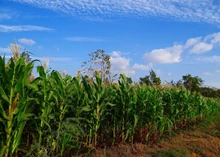
The crop area has risen by 2.61 percent from last year, based on higher planting of pulses and oilseeds. According to the Ministry of Agriculture, the region seeded for wheat, the main Rabi crop, has also risen by 2.53 percent to 33.54 million hectares so far in the current 2020-21 rabi season from 32.67 million hectares in the year-ago period.
'In the field of pulses and oilseeds, there is a large spike, indicating a bumper crop this year. The area of pulses has increased by 4.52 percent, while the area of oilseeds, primarily mustard, has increased by 5.15 percent. This is likely to reduce our reliance on imports,' a senior official in the Ministry of Agriculture said.
He said there was barely any effect on crop planting from the agitation of farmers. In Punjab, where there is highest opposition, wheat sowing covering over 3.5 million hectares is almost complete.
'The minimum support price (MSP) declaration before sowing has a positive effect on sowing. The area has grown significantly under more rewarding crops such as oilseeds and pulses. The storage houses, they are filled with wheat and rice' the official said.
Moderate rainfall and cold weather conditions in North India have led to healthy crop development. During this time, water balance in 128 main reservoirs across the country is 20 percent higher than the average over the last 10 years.
'The supply of irrigation water has resulted in an improvement in the rice region by 2.69 percent over the previous year. Rice sowing had lagged before last week, relative to last year. Rain, however, helped farmers increase the rice field. However, relative to usual sowing, the rice area is still down by 55 per cent, covering 4.17 million hectares during this time,' the official said.
Due to the lack of price support on the market, the sowing of coarse plants such as jowar, barley and maize is down by 7.14 percent from last year.
Last week, Agriculture Minister Narendra Singh Tomar told that the production of food grains in this rabid season would exceed the production of 153.27 million tonnes last year.
He said, 'we're going to achieve yet another bumper production this year'.
Meanwhile, the government has also stepped up the procurement exercise to purchase more than 52 million tons of paddy for its central reservoir, which is 27 percent more than during this time last year. So far, Punjab alone has contributed approximately 39 percent of the overall procurement.
'The government has transferred around Rs one lakh crore against procurement to over 6.8 million rice farmers,' the official added.











